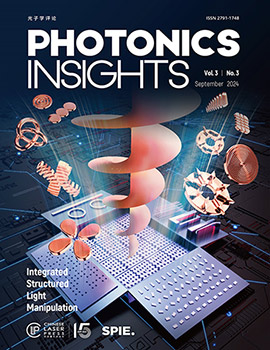Jian Wang, Kang Li, Zhiqiang Quan
Photonics Insights, Vol. 3, Issue 03, R05, (September 2024) https://doi.org/10.3788/PI.2024.R05

TOPICS: Structured light, Silicon, Waveguides, Lithium, Airy beams, Spiral phase plates, Multiplexing, Polarization, Waveguide modes, Holography
Structured light, also known as tailored light, shaped light, sculpted light, or custom light, refers to a series of special light beams with spatially variant amplitudes and phases, polarization distributions, or more general spatiotemporal profiles. In the past decades, structured light featuring distinct properties and unique spatial or spatiotemporal structures has grown into a significant research field and given rise to many developments from fundamentals to applications. Very recently, integrated structured light manipulation has become an important trend in the frontier of light field manipulation and attracted increasing interest as a highly promising technique for shaping structured light in an integrated, compact, and miniaturized manner. In this article, we give a comprehensive overview of recent advances in integrated structured light manipulation (generation, processing, detection, and application). After briefly introducing the basic concept and development history of structured light, we present representative works in four important aspects of integrated structured light manipulation, including multiple types of integrated structured light generation, many sorts of integrated structured light processing, diverse forms of integrated structured light detection, and various kinds of integrated structured light applications. We focus on summarizing the progress of integrated structured light manipulation from basic theories to cutting-edge technologies, to key devices, and to a wide variety of applications, from orbital angular momentum carrying light beams to more general structured light beams, from passive to active integration platforms, from micro-nano structures and metasurfaces to 2D photonic integrated circuits and 3D photonic chips, from in-plane to out-of-plane, from multiplexing to transformation, from linear to nonlinear, from classical to quantum, from optical communications to optical holography, imaging, microscopy, trapping, tweezers, metrology, etc. Finally, we also discuss in detail the future trends, opportunities, challenges, and solutions, and give a vision for integrated structured light manipulation.



 Receive Email Alerts
Receive Email Alerts